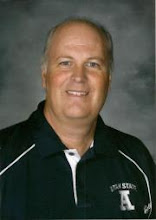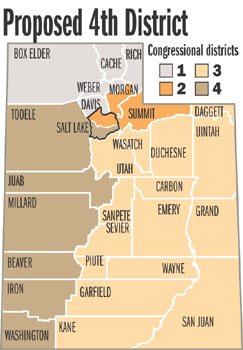Huntsman unveils map proposing 4 districts
By Bob Bernick Jr. and Suzanne StruglinskiDeseret Morning News
Gov. Jon Hunstman Jr. unveiled a new four-congressional district map Wednesday as negotiations continue in Washington to grant Utah an additional seat in the U.S. House of Representatives.
"It is imperative that we come together and do what is best for Utah. Clearly, it is in our best interest to gain a much needed and deserved fourth seat," Huntsman said Wednesday. "This map is consistent with my pledge of fairness made last week to the Judiciary Committee of the House of Representatives." Committee Chairman James Sensenbrenner, R-Wis., wants to change a pending bill that would give Utah a fourth House seat that is at-large until the 2010 Census, instead creating four distinct geographic districts that would be established by the state. Huntsman testified before the committee last week in Washington, saying while he preferred the at-large option, redistricting could be done fairly. "Whether we like it or not, that legislation granting Utah a fourth congressional seat can only make it through the House Judiciary Committee with an amendment striking the 'at-large' election provision," said Rep. Chris Cannon, R-Utah. "I have made it clear, and I think many Utahns agree, that what matters is that we get the additional seat we deserve and for which we have fought so hard." The Utah seat is a political compromise in a bill that grants a vote in the House for the District of Columbia, where residents currently do not have a voting member in the House or Senate. Del. Eleanor Holmes Norton, D-D.C. is still working on a compromise to get the bill through, according to her office. Cannon encouraged the governor and Utah's state legislative leaders to work with Rep. Jim Matheson, D-Utah, "to provide the assurances he apparently needs in order to embrace a process that will lead to a fair reapportionment."
document.writeln(AAMB6);
document.write(''); "We should not lose this opportunity to gain the fourth seat we so clearly deserve due to the partisan interests of any member of the delegation," Cannon said. But Matheson says it's up to the Republicans to make sure this bill goes through and he is not the one preventing it from moving forward. "I have always said Utah deserves an additional voice in Congress," Matheson said in a statement. "Utah should have been given a fourth seat after the 2000 Census. I've supported bipartisan legislation that would accomplish the goal. That compromise bill took partisanship out of the mix, and it seemed likely to move forward, until one member of Congress blocked the bill's progress. If it gets unstuck, I look forward to voting for it. But clearly the ball is in the majority party's court." Matheson spokeswoman Alyson Heyrend said Matheson would vote for a bill giving Utah a fourth seat, whether it creates a fourth district or an at-large position. She said it was "way too hypothetical" to comment on the maps released by the governor Wednesday. "Congress isn't going to pass any maps, that is putting the cart before the horse," Heyrend said. "The Utah Legislature does the redistricting." She said Matheson's office knew nothing about the maps until the governor's press release came out. "Who knows what the Utah Legislature will do," Heyrend said. Meanwhile back in Utah, Huntsman, state House Speaker Greg Curtis and Senate President John Valentine, all Republicans, quickly met Wednesday to give preliminary approval to a four-district alternative. Oddly enough, it was not the four-district plan that was formally adopted by the 2001 GOP-controlled Legislature and former GOP Gov. Mike Leavitt. Leaders adopted a four-district plan then just in case Utah won its U.S. Supreme Court challenge to the U.S. Census data from which North Carolina, not Utah, was given an extra U.S. House seat. Utah ultimately lost that court challenge, and so a new three-district redistricting plan was adopted. Todd Taylor, executive director of the Utah Democratic Party, was not pleased with what he saw under the new four-district plan Wednesday. "First off, on its face, it is illegal," said Taylor, who has led state Democrats through two previous statewide redistricting efforts, in 1991 and in 2001. Court-tested redistricting law says that each district's population can vary only by 0.5 percent from other districts', Taylor said. The four districts put forward by GOP leaders Wednesday show population variations of 2.39 percent, 2.52 percent, 4.21 percent and 0.70 percent, respectively. "This shows Utah's Republicans going back to their old tendencies," Taylor said. "They either dump all the Democrats they can into one district, or they break up all the Democrats they can into all the districts." Curtis said: "We were told to draw up a map that was very fair to Congressman Matheson. We did that. Of the 15 Utah House seats that Democrats hold in Salt Lake County, the new 2nd District has 14 of them. I told the governor I don't know how we could have drawn it any more Democratic." Taylor said despite artificial deadlines that GOP leaders in Washington may have put on Utah to suggest a four-district plan, this is not the way to go about it. "As bad as the four-seat plan adopted" in 2001 "may have been, at least there was an open hearing process. They come up with this map in one day with no hearings at all. I got my map from a newspaper reporter," Taylor said. There will still be public hearings and "tweaking" of the boundaries to get each of the four new districts' populations below 0.5 percent deviation, Curtis said. The four-district plan GOP leaders put together Wednesday may actually put more Democrats into Matheson's new 2nd District than he has in his current 2nd District, which takes in the eastern part of Salt Lake County and counties to the east, south and southwest. His is one of the largest geographic districts in the nation. Under the new four-district plan, Matheson would pick up more of the west side of the county, all of Summit County (which he has now) and then north into Morgan County. The county's west side and the 7,100 residents in Morgan County would be new for him. While Matheson would pick up new constituents in Morgan County and the west side of Salt Lake County, he probably would be better off in his Democrat/Republican ratio. But, by making a safe Democratic seat, Republicans could also be making the other three seats even more secure for Republicans — and thus for a decade or more making it nearly impossible for Democrats to capture a second Utah congressional seat. "I don't know how to answer that complaint," Curtis said. "I guess Todd Taylor just is having a bad day and won't be happy with anything we do."
E-mail: bbjr@desnews.com; suzanne@desnews.com






No comments:
Post a Comment